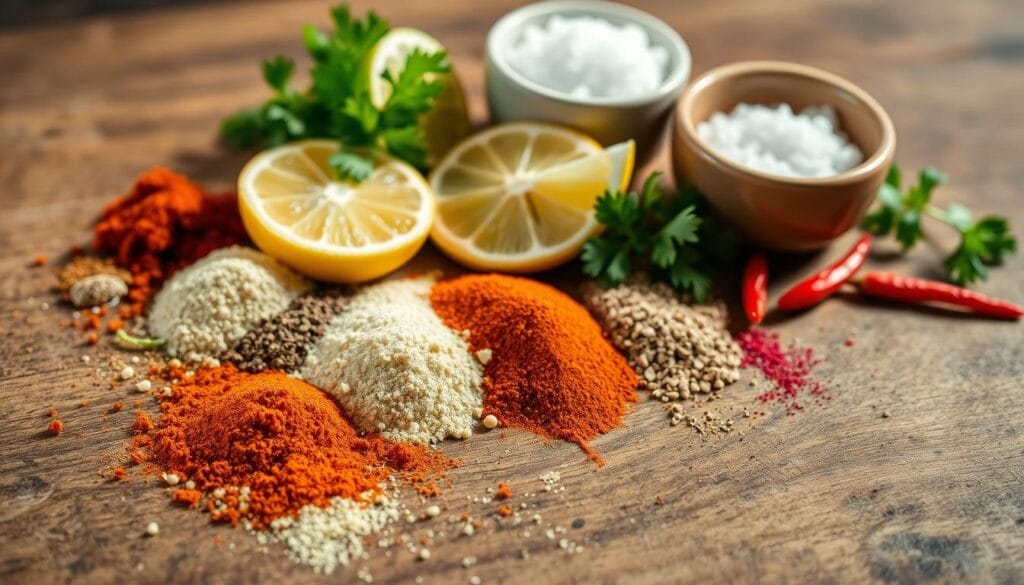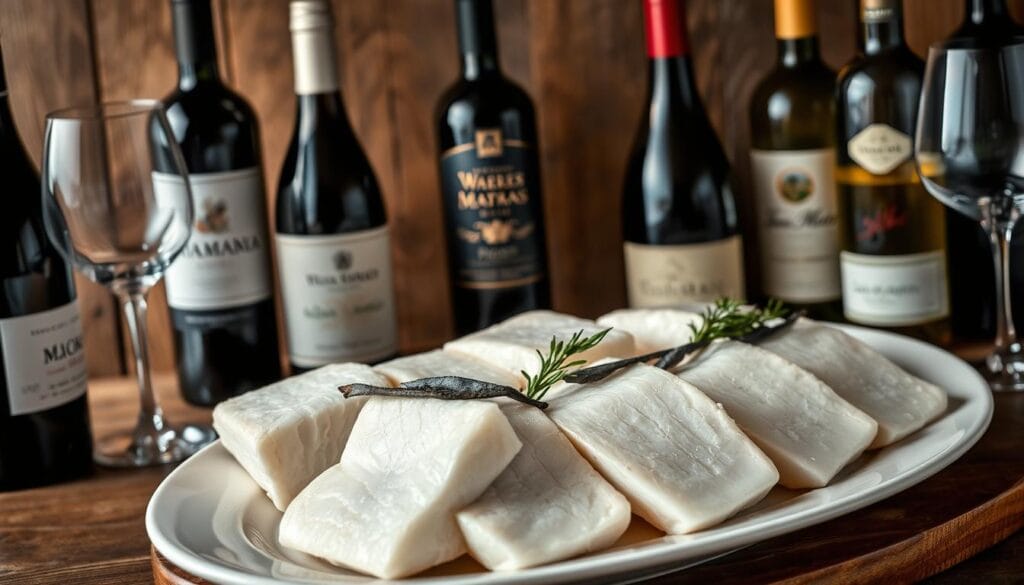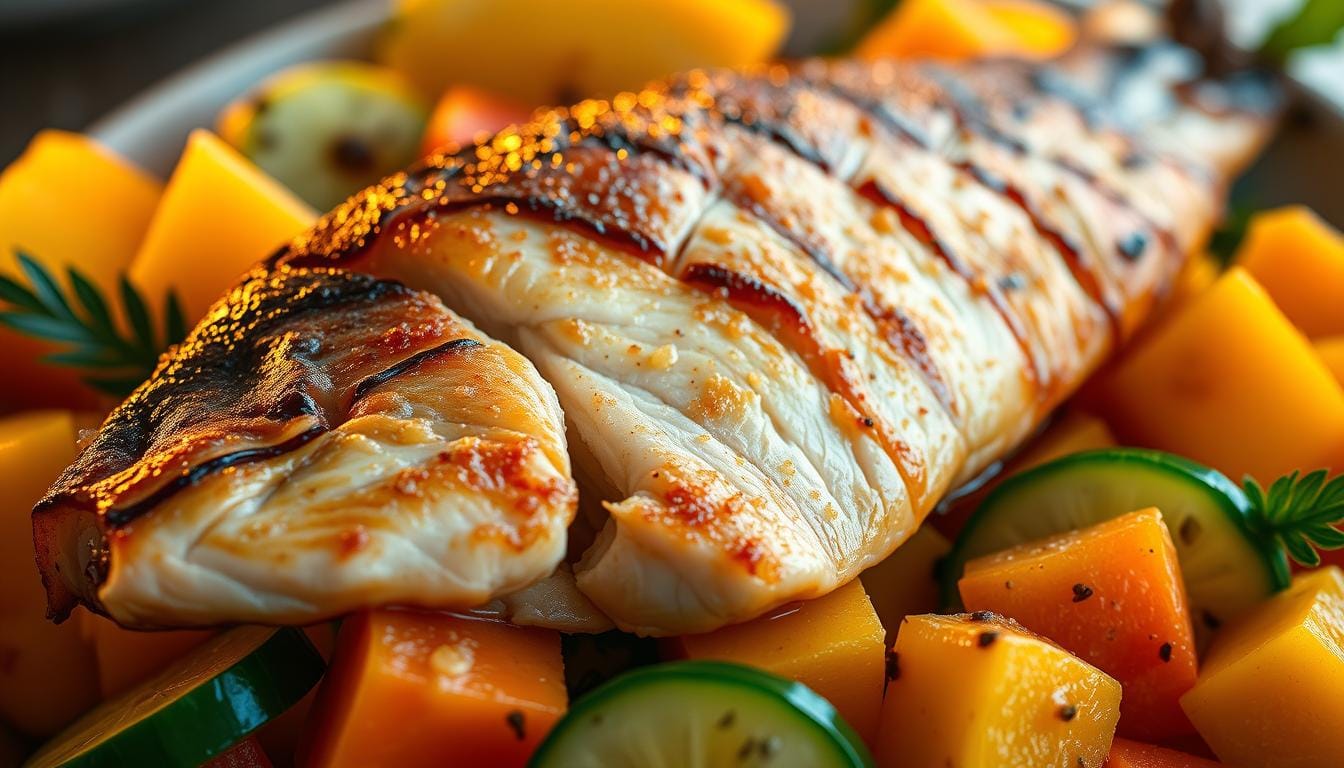The first time I tried mahi mahi at a coastal restaurant, I was drawn to its bright look and enticing smell. As someone who loves seafood, I knew this fish was unique. Its flavor profile was like a call to explore its special taste.
Table of Contents
Wondering what mahi mahi tastes like? You’re in for a treat. This fish has a mild, sweet flavor that stands out from other seafood. Its firm, flaky texture makes every bite memorable, appealing to both seafood fans and newcomers.
Mahi mahi, also known as dolphinfish, has a taste that’s both delicate and strong. Its natural sweetness and clean flavor make it perfect for many cooking methods, like grilling or baking.
what does mahi mahi taste like
Key Takeaways
- Mahi mahi features a mild, sweet flavor profile
- The fish has a firm and flaky texture
- Versatile for multiple cooking techniques
- Appealing to both seafood experts and novices
- Offers a unique taste experience compared to other fish
Understanding Mahi Mahi’s Unique Flavor Profile
Dive into the world of mahi mahi, a fish that stands out in the seafood landscape with its exceptional taste and texture. When exploring mahi mahi taste description, you’ll discover a culinary experience that delights seafood enthusiasts and casual diners alike.
The mahi mahi flavor characteristics are truly remarkable. This vibrant fish offers a unique profile that sets it apart from other seafood options. Its taste is distinctly different, with a delicate balance of sweetness and mild oceanic notes that make it a favorite among chefs and home cooks.
Sweet and Mild Base Notes
At the heart of mahi mahi’s appeal are its sweet and mild base notes. Unlike stronger-tasting fish, mahi mahi presents a gentle flavor that doesn’t overwhelm the palate. The natural sweetness comes through subtly, making it an excellent choice for those who typically find fish too intense.
- Mild, clean taste with a hint of sweetness
- Less fishy compared to other seafood options
- Versatile flavor that pairs well with various seasonings
Texture and Moisture Content
Texture plays a crucial role in mahi mahi’s culinary appeal. The fish boasts a firm yet flaky consistency that holds up beautifully during cooking. Its impressive moisture retention ensures that each bite remains juicy and tender, whether you’re grilling, baking, or pan-searing.
Comparing to Other Fish Species
When placed side by side with other fish, mahi mahi truly shines. Its unique flavor profile stands out from the more robust tastes of mackerel or sardines, and it’s less delicate than sole or tilapia. This makes mahi mahi an ideal choice for those seeking a balanced seafood experience.
A fish that transforms from ocean to plate with exceptional flavor and texture!
The Origin and Habitat of Mahi Mahi
Mahi mahi is a favorite fish in many cuisines. It lives in warm, tropical waters. These vibrant fish add a unique flavor to seafood dishes.
Mahi mahi can be found in several key places:
- Gulf of Mexico
- Caribbean Sea
- Hawaiian waters
- Indian Ocean
- Pacific Ocean tropical zones
Knowing where mahi mahi lives helps us understand its taste. Tropical waters are rich in nutrients. They create the fish’s exceptional flavor.
| Ocean Region | Water Temperature | Average Mahi Mahi Population |
|---|---|---|
| Gulf of Mexico | 75-85°F | High |
| Hawaiian Waters | 70-80°F | Moderate |
| Indian Ocean | 77-86°F | Substantial |
“Mahi mahi’s habitat directly influences its culinary potential, making each bite a journey through tropical marine ecosystems.” – Seafood Culinary Institute
The way mahi mahi is caught is very important. It’s caught in a way that protects the ocean. This ensures the fish tastes great and the ocean stays healthy for others to enjoy.
What Does Mahi Mahi Taste Like?
Exploring mahi mahi’s unique flavor can change how you enjoy seafood. This fish has a special taste that makes it stand out. It’s a journey of flavors waiting to be discovered.
Mahi mahi’s taste is distinct. Wild-caught mahi mahi tastes sweet and mild. It’s firm and clean, perfect for many dishes.
Fresh vs Frozen Flavor Nuances
Fresh and frozen mahi mahi taste differently. Fresh mahi mahi is sweeter and firmer. It has a brighter taste.
Frozen mahi mahi might taste slightly different. But, the right freezing and thawing can keep its flavor.
Raw vs Cooked Taste Exploration
Raw and cooked mahi mahi taste worlds apart. Raw mahi mahi is delicate and sweet. Cooking makes it sweeter and more complex.
Seasonal Taste Variations
Mahi mahi’s flavor changes with the seasons. Water temperature, diet, and where it’s caught all play a part. This means its taste can vary all year.
“The beauty of mahi mahi lies in its ability to capture the essence of its marine environment.” – Seafood Culinary Expert
Knowing about these flavor changes lets you enjoy mahi mahi even more. Each bite is a new adventure in taste.
Nutritional Benefits and Health Value
Explore the amazing mahi mahi culinary experience. It’s a nutritional powerhouse that can change your diet. This tasty fish is packed with health benefits, making it perfect for those who care about their health.
Mahi mahi is a top choice for lean protein. It’s full of nutrients that help your muscles and overall health. Here are some key health benefits it offers:
- High-quality protein for muscle maintenance
- Omega-3 fatty acids supporting heart health
- Essential vitamins and minerals
The omega-3 fatty acids in mahi mahi are very important. These healthy fats help reduce inflammation, support brain function, and keep your heart healthy. Eating it can add a lot of nutritional value to your diet.
| Nutrient | Benefit |
|---|---|
| Vitamin B12 | Supports nervous system and red blood cell formation |
| Selenium | Boosts immune function and protects cells |
| Potassium | Regulates blood pressure and supports heart health |
Your mahi mahi culinary experience is more than just delicious. It’s about feeding your body with a nutrient-rich seafood option. This supports your health and wellness goals.
Best Cooking Methods for Optimal Flavor
Mahi mahi is a versatile fish that can be cooked in many ways. Each method brings out its unique flavors. Choosing the right cooking method is key to enjoying a great meal.
Every cooking method changes how mahi mahi tastes. You can explore its flavors by trying different techniques.
Pan-Searing Techniques
Pan-searing makes the outside crispy and keeps the inside moist. Here’s how to do it:
- Pat the mahi mahi dry with paper towels
- Season with salt and pepper
- Use a hot, well-oiled skillet
- Cook for 3-4 minutes per side
Grilling Tips
Grilling adds smoky flavors that match mahi mahi’s sweetness. Here’s what to do:
- Marinate for 30 minutes before grilling
- Preheat grill to medium-high heat
- Clean and oil grill grates
- Grill for 4-5 minutes per side
Baking Instructions
Baking is a gentle way to cook that keeps flavors and moisture. Here’s how to bake it right:
| Temperature | Cooking Time | Recommended Seasoning |
|---|---|---|
| 400°F | 10-12 minutes | Lemon, herbs, garlic |
| 375°F | 12-15 minutes | Cajun spice, olive oil |
Each cooking method shows a different side of mahi mahi’s flavor. Your choice depends on what you like and what you want to achieve.
Flavor-Enhancing Ingredients and Seasonings

To make mahi mahi taste better, choose ingredients that match its mild, sweet flavor. Knowing the right seasonings can turn this fish into a dish to remember.
- Citrus-based enhancements like lemon and dill
- Tropical fruit pairings such as mango and cilantro
- Savory herb combinations including garlic and rosemary
- Spicy profiles with chili and lime
Marinades play a big role in mahi mahi’s taste. Here are some great choices:
- Citrus Herb Marinade: Olive oil, lemon juice, fresh parsley, basil
- Spicy Mango Marinade: Pureed mango, lime juice, chili flakes
- Teriyaki Marinade: Soy sauce, brown sugar, rice vinegar, ginger
Exploring different cuisines brings new flavors to mahi mahi:
| Cuisine | Flavor Profile | Key Ingredients |
|---|---|---|
| South American | Herbaceous | Chimichurri sauce, parsley, cilantro |
| Tropical | Fruity | Pineapple salsa, jalapeños |
| Asian-Inspired | Savory-Sweet | Teriyaki glaze, soy sauce, honey |
Trying out these ingredients will help you enjoy mahi mahi’s amazing taste.
Selecting and Storing Mahi Mahi
Your mahi mahi eating experience starts with picking and storing the fish right. Fresh mahi mahi can make your cooking journey amazing. It’s key to choose and store it well to keep its great taste.
Choosing mahi mahi is all about using your senses. Here’s what to look for:
- Firm, shiny flesh that springs back when touched
- Skin with a natural metallic sheen
- Tight scales firmly attached
- Bulging, clear eyes without cloudiness
- Bright red or pink, moist gills
Fresh Fish Selection Guide
Freshness is key to mahi mahi’s taste. A fresh fish smells like the ocean. Avoid any fish with strong, fishy, or sour odors, as these are signs of spoilage.
Storage Best Practices
Storing mahi mahi right keeps its taste and texture fresh. Here’s a guide:
| Storage Method | Temperature | Duration | Recommended Technique |
|---|---|---|---|
| Refrigeration | 32°F (0°C) | 1-2 days | Wrap tightly in moisture-proof paper, place in airtight container |
| Freezing | 0°F (-18°C) | 3-4 months | Wrap in plastic wrap and aluminum foil |
Thawing needs careful handling. The safest way is slow thawing in the fridge, which takes 12-48 hours. Don’t thaw at room temperature to avoid bacterial growth.
Pro tip: Always use fresh mahi mahi within a day or two of purchase for the best mahi mahi eating experience.
Popular Mahi Mahi Recipes and Preparations
Exploring mahi mahi cooking shows a world of tasty options. This fish fits many cooking styles, loved by both home cooks and chefs. Start your mahi mahi flavor journey with classic dishes that show off its special taste.
- Tropical Mahi Mahi Tacos: A zesty street food-inspired dish that combines grilled fish with fresh slaw
- Blackened Mahi Mahi Fillets: A spicy Southern-style preparation with bold seasoning
- Mediterranean Mahi Mahi: Baked with olives, tomatoes, and herbs for a light, refreshing meal
For a great mahi mahi dish, know its delicate flavor and pick the right ingredients. Use citrus marinades, light herbs, and gentle cooking to keep its natural sweetness.
| Cooking Method | Flavor Intensity | Recommended Seasonings |
|---|---|---|
| Grilling | Medium | Lime, Chili, Cilantro |
| Pan-Searing | High | Cajun Spice, Garlic |
| Baking | Light | Lemon, Dill, Butter |
Mahi mahi is perfect for quick dinners or fancy dinner parties. It lets your kitchen become a place for fun and discovery.
Wine and Side Dish Pairings

Improving your mahi mahi meal is more than just cooking the fish right. The perfect wine and side dishes can make your meal unforgettable. They bring out the fish’s unique flavors.
Complementary Beverages
Finding the right drink can really enhance your mahi mahi meal. White wines pair well with this mild fish:
- Sauvignon Blanc – crisp and acidic
- Pinot Grigio – light and refreshing
- Chardonnay – for a buttery complement
If you prefer not to drink alcohol, try these:
- Sparkling water with citrus
- Cucumber-infused drinks
- Light green tea
Recommended Side Dishes
Match your mahi mahi with sides that enhance its sweet taste. These choices will make your meal complete:
- Tropical Salsa – mango or pineapple-based
- Roasted Mediterranean vegetables
- Coconut rice
- Quinoa with herbs
Pro tip: Choose sides with bright, fresh flavors that won’t overpower the delicate taste of mahi mahi.
Sustainable Fishing and Quality Impact
Sustainable fishing is key to keeping mahi mahi’s great taste. Choosing fish caught responsibly helps the ocean and your taste buds.
The link between green fishing and mahi mahi’s taste is strong. Fish caught the right way keeps its natural flavor better. So, you get a more real and tasty mahi mahi when it’s sustainably caught.
- Responsible fishing protects marine ecosystems
- Sustainable practices preserve fish quality
- Eco-friendly methods maintain nutritional value
When buying mahi mahi, look for these signs:
- Marine Stewardship Council (MSC) certification
- Seafood Watch program recommendations
- Local sustainable fishing network endorsements
“Sustainable fishing isn’t just about protecting the ocean—it’s about preserving the incredible flavor of mahi mahi for future generations.”
Supporting green fishing helps marine life and gives you top-notch seafood. Your choice helps the ocean and makes your mahi mahi meals unforgettable.
Common Cooking Mistakes to Avoid
Mastering the mahi mahi flavor analysis means avoiding key cooking errors. These mistakes can ruin the fish’s texture and taste. Many home cooks unintentionally mess up this delicate fish by making simple mistakes.
The biggest mistake in cooking mahi mahi is overcooking it. This lean fish becomes dry and tough when cooked too long. You should aim to keep its natural moisture and flavor.
- Avoid cooking mahi mahi beyond 145°F internal temperature
- Watch for fish becoming opaque and flaking easily
- Remove from heat immediately when color changes
Seasoning is key to a great mahi mahi eating experience. Too little seasoning makes it taste bland, while too much hides its sweetness. Choose light herbs and citrus-based marinades to bring out the fish’s natural taste.
“Cooking mahi mahi is an art of precision and restraint” – Professional Chef Marcus Rodriguez
Temperature control is also vital. Use medium-high heat and quick cooking methods like grilling or pan-searing. Avoid flipping or moving the fish too much to keep it tender.
- Preheat cooking surface before adding fish
- Use minimal oil to prevent sticking
- Cook for 3-4 minutes per side maximum
By knowing these common mistakes, you can improve your mahi mahi cooking. This will make your seafood experience consistently delicious.
Conclusion
Understanding mahi mahi’s taste is more than just flavor. This fish offers a unique mix of mild sweetness and firm texture. It’s a seafood that fits well with many cooking styles and flavors.
Mahi mahi’s taste is special because it takes on marinades and spices well. It stays delicate in taste. You can pan-fry, grill, or bake it, making it a canvas for your cooking.
Knowing more about mahi mahi lets you cook it with confidence. You can now choose, prepare, and enjoy it like a pro. Try new recipes and flavors to make your kitchen a place of culinary discovery.
Start your culinary journey with mahi mahi. It’s not just a meal; it’s a chance to explore new tastes. It’s a fish that can take your seafood dishes to the next level.
FAQ
What does mahi mahi taste like?
Mahi mahi tastes mild and sweet. It has a firm, flaky texture. This makes it appealing to many, even those who don’t usually like fish.
Its clean taste makes it great for many dishes.
Is mahi mahi similar to other fish in taste?
Mahi mahi is similar to some fish but has its own sweet flavor. It’s not as delicate as tilapia but not as strong as salmon. It’s in the middle in terms of flavor.
How should I cook mahi mahi to preserve its best flavor?
Cook mahi mahi gently to keep its flavor and texture. Use pan-searing, grilling, or baking. Don’t overcook it.
Aim for a golden outside and a moist inside. Cook for 3-4 minutes per side.
Is mahi mahi a healthy fish to eat?
Yes! Mahi mahi is full of lean protein, omega-3s, vitamins, and minerals. It’s low in calories and high in nutrients. It’s good for your heart and muscles.
Where does mahi mahi come from?
Mahi mahi lives in tropical and subtropical waters worldwide. It’s found in the Caribbean, Gulf of Mexico, and Pacific Ocean. Its habitat gives it a mild, sweet taste.
What are the best seasonings for mahi mahi?
Use bright, fresh flavors like lemon, garlic, and herbs. Citrus, tropical spices, and Mediterranean herbs are great too. They enhance its natural sweetness.
How can I tell if mahi mahi is fresh?
Look for a bright, clear appearance and a clean smell. Fresh mahi mahi is firm and elastic. Avoid fish with a strong smell or dull color.
Can I eat mahi mahi raw?
Some like mahi mahi raw in dishes like ceviche. But, it must be extremely fresh. For safety, most say to cook it to 145°F (63°C).
How should I store mahi mahi?
Keep it in the coldest part of your fridge at 32-38°F. Wrap it tightly or use an airtight container. Use it within 1-2 days. Freeze for longer storage, up to 3-4 months.
What wines pair well with mahi mahi?
Light, crisp white wines are best. Sauvignon Blanc, Pinot Grigio, and unoaked Chardonnay are good. They complement its flavor without overpowering it.


